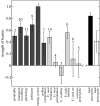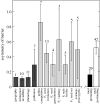Review. The strength and genetic basis of reproductive isolating barriers in flowering plants
- PMID: 18579478
- PMCID: PMC2607309
- DOI: 10.1098/rstb.2008.0064
Review. The strength and genetic basis of reproductive isolating barriers in flowering plants
Abstract
Speciation is characterized by the evolution of reproductive isolation between two groups of organisms. Understanding the process of speciation requires the quantification of barriers to reproductive isolation, dissection of the genetic mechanisms that contribute to those barriers and determination of the forces driving the evolution of those barriers. Through a comprehensive analysis involving 19 pairs of plant taxa, we assessed the strength and patterns of asymmetry of multiple prezygotic and postzygotic reproductive isolating barriers. We then reviewed contemporary knowledge of the genetic architecture of reproductive isolation and the relative role of chromosomal and genic factors in intrinsic postzygotic isolation. On average, we found that prezygotic isolation is approximately twice as strong as postzygotic isolation, and that postmating barriers are approximately three times more asymmetrical in their action than premating barriers. Barriers involve a variable number of loci, and chromosomal rearrangements may have a limited direct role in reproductive isolation in plants. Future research should aim to understand the relationship between particular genetic loci and the magnitude of their effect on reproductive isolation in nature, the geographical scale at which plant speciation occurs, and the role of different evolutionary forces in the speciation process.
Figures



References
-
- Aldridge G, Campbell D.R. Asymmetrical pollen success in Ipomopsis (Polemoniaceae) contact sites. Am. J. Bot. 2006;93:903–909. doi:10.3732/ajb.93.6.903 - DOI - PubMed
-
- Angert A.L, Schemske D.W. The evolution of species' distributions: reciprocal transplants across the elevation ranges of Mimulus cardinalis and M. lewisii. Evolution. 2005;59:1671–1684. doi:10.1554/05-107.1 - DOI - PubMed
-
- Arnold S.J, Verrell P.A, Tilley S.G. The evolution of asymmetry in sexual isolation: a model and a test case. Evolution. 1996;50:1024–1033. doi:10.2307/2410643 - DOI - PubMed
-
- Barton N.H, Bengtsson B.O. The barrier to genetic exchange between hybridizing populations. Heredity. 1986;57:357–376. doi:10.1038/hdy.1986.135 - DOI - PubMed
-
- Beavis, W. D. 1994 The power and deceit of QTL experiments: lessons from comparative QTL studies. In Proc. 49th Annual Corn and Sorghum Industry Research Conference, pp. 250–266. Washington, DC: American Seed Trade Association.
Publication types
MeSH terms
LinkOut - more resources
Full Text Sources
Other Literature Sources
